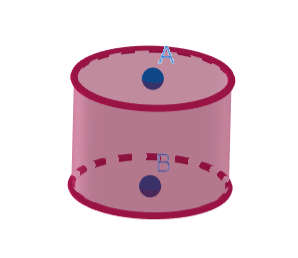
How many coins of $1.75$ cm diameter and $2$mm thick must be melted to form a cuboid $11$ cm $\times $ $10$ cm $\times $ $7$ cm?
Answer
555.9k+ views
Hint: In this question we have the coin which is the shape of a cylinder having the dimensions $1.75$ cm diameter and $2$mm thick. Now we will calculate the volume of one cylindrical coin having the given dimensions. Now we will assume that $n$ number of coins can be melted to form a cuboid of dimensions $11$ cm $\times $ $10$ cm $\times $ $7$ cm. So, we will calculate the volume of $n$ coins by multiplying $n$ with the volume of one coin and equate it to the volume of the cuboid to get the value of $n$.
Complete step by step answer:
Given that,
A coin has $1.75$ cm diameter and $2$mm thickness as shown in below figure

Radius of the cylinder $R=\dfrac{\text{diameter}}{2}=\dfrac{1.75}{2}cm$
Height of the cylinder $H=2mm$
Here the radius and the height of the cylinder are not in the same units, so we need to convert any one of these into another one. For this problem we will convert height of the cylinder into centimeters, by using the relation we have between the centimeters and millimeters i.e., $1cm=10mm\Rightarrow 1mm=\dfrac{1}{10}cm$
Now the height of the cylinder in centimeters is given by
$\begin{align}
& H=2\times \dfrac{1}{10}cm \\
& \Rightarrow H=0.2cm \\
\end{align}$
The volume of cylindrical coin is
$\begin{align}
& {{V}_{1}}=\pi {{R}^{2}}H \\
& \Rightarrow {{V}_{1}}=\pi {{\left( \dfrac{1.75}{2} \right)}^{2}}\times 0.2 \\
& \Rightarrow {{V}_{1}}=0.153\pi c{{m}^{3}} \\
\end{align}$
Let $n$ number of coins are melted to form a cuboid of dimensions $11$ cm $\times $ $10$ cm $\times $ $7$ cm. Hence the total volume of the $n$ coins should be equal to the volume of the cuboid. Let ${{V}_{2}}$ be the volume of the cuboid.
$\therefore n\times {{V}_{1}}={{V}_{2}}$
We know that the volume of a cuboid having the dimensions $a\times b\times c$ is equal to the product of the dimensions.
$\Rightarrow n\times {{V}_{1}}=11\times 10\times 7c{{m}^{3}}$
Substituting the value of ${{V}_{1}}$ in the above equation, then we will get
$\begin{align}
& \Rightarrow n\times 0.153\pi c{{m}^{3}}=770c{{m}^{3}} \\
& \Rightarrow n=\dfrac{770}{0.153\times \pi } \\
& \Rightarrow n=1602.76 \\
& \Rightarrow n\simeq 1603 \\
\end{align}$
So, we need to melt nearly $1600$ coins to form a cuboid of dimension $11$ cm $\times $ $10$ cm $\times $ $7$ cm.
Note: While dealing with this type of problems we need to check the units of the variables while performing the operations. Here we have converted the height of the coin into centimeters because all the remaining variables are given in centimeters. If the remaining variables are given in meters then we need to convert the height/thickness into the meters.
Complete step by step answer:
Given that,
A coin has $1.75$ cm diameter and $2$mm thickness as shown in below figure

Radius of the cylinder $R=\dfrac{\text{diameter}}{2}=\dfrac{1.75}{2}cm$
Height of the cylinder $H=2mm$
Here the radius and the height of the cylinder are not in the same units, so we need to convert any one of these into another one. For this problem we will convert height of the cylinder into centimeters, by using the relation we have between the centimeters and millimeters i.e., $1cm=10mm\Rightarrow 1mm=\dfrac{1}{10}cm$
Now the height of the cylinder in centimeters is given by
$\begin{align}
& H=2\times \dfrac{1}{10}cm \\
& \Rightarrow H=0.2cm \\
\end{align}$
The volume of cylindrical coin is
$\begin{align}
& {{V}_{1}}=\pi {{R}^{2}}H \\
& \Rightarrow {{V}_{1}}=\pi {{\left( \dfrac{1.75}{2} \right)}^{2}}\times 0.2 \\
& \Rightarrow {{V}_{1}}=0.153\pi c{{m}^{3}} \\
\end{align}$
Let $n$ number of coins are melted to form a cuboid of dimensions $11$ cm $\times $ $10$ cm $\times $ $7$ cm. Hence the total volume of the $n$ coins should be equal to the volume of the cuboid. Let ${{V}_{2}}$ be the volume of the cuboid.
$\therefore n\times {{V}_{1}}={{V}_{2}}$
We know that the volume of a cuboid having the dimensions $a\times b\times c$ is equal to the product of the dimensions.
$\Rightarrow n\times {{V}_{1}}=11\times 10\times 7c{{m}^{3}}$
Substituting the value of ${{V}_{1}}$ in the above equation, then we will get
$\begin{align}
& \Rightarrow n\times 0.153\pi c{{m}^{3}}=770c{{m}^{3}} \\
& \Rightarrow n=\dfrac{770}{0.153\times \pi } \\
& \Rightarrow n=1602.76 \\
& \Rightarrow n\simeq 1603 \\
\end{align}$
So, we need to melt nearly $1600$ coins to form a cuboid of dimension $11$ cm $\times $ $10$ cm $\times $ $7$ cm.
Note: While dealing with this type of problems we need to check the units of the variables while performing the operations. Here we have converted the height of the coin into centimeters because all the remaining variables are given in centimeters. If the remaining variables are given in meters then we need to convert the height/thickness into the meters.
Recently Updated Pages
What happens to glucose which enters nephron along class 10 biology CBSE

Write a dialogue with at least ten utterances between class 10 english CBSE

A circle is inscribed in an equilateral triangle and class 10 maths CBSE

When the JanmiKudian Act was passed that granted the class 10 social science CBSE

A sector containing an angle of 120 circ is cut off class 10 maths CBSE

The sum of digits of a two digit number is 13 If t-class-10-maths-ICSE

Trending doubts
The shortest day of the year in India

Why is there a time difference of about 5 hours between class 10 social science CBSE

Write a letter to the principal requesting him to grant class 10 english CBSE

What is the median of the first 10 natural numbers class 10 maths CBSE

The Equation xxx + 2 is Satisfied when x is Equal to Class 10 Maths

What is the missing number in the sequence 259142027 class 10 maths CBSE




